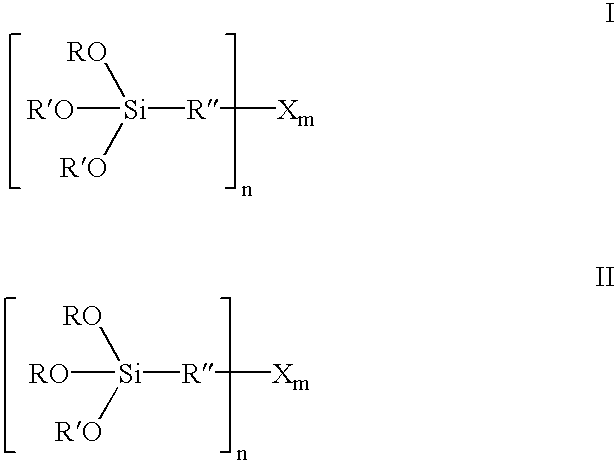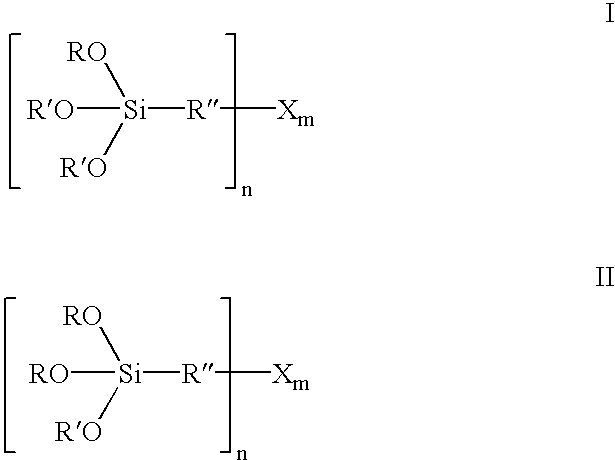Organosilicon compounds
a technology of organic compounds and silanes, which is applied in the field of organic compounds, can solve the problems of large amounts of alcohol released during and after bonding to the filler, the inability to dispense with the use of methoxy-ethoxy-substituted silanes, and the release of volatile alcohols, such as methanol and ethanol, into the environment, and achieves the effect of enhancing reactivity during bonding
- Summary
- Abstract
- Description
- Claims
- Application Information
AI Technical Summary
Benefits of technology
Problems solved by technology
Method used
Image
Examples
example 1
200.0 g of bis(3-triethoxysilylpropyl)polysulfane (formula III where R=ethyl, R″=CH2CH2CH2, X=S, n=2 and m=3.8) and 70.0 g of 1-dodecanol (R′=C12H25) are initially introduced at room temperature into a 1 liter four-necked flask with distillation attachment and combined with 1.0 g of Amberlyst 15. The yellowish solution is heated to 100-130° C., the resultant ethanol removed by distillation and 210 g of 1-dodecanol are added dropwise within 1.5 h. The resultant ethanol is continuously removed by distillation. Towards the end of the reaction, the temperature is briefly raised to 150° C. The mixture is then distilled in a rotary evaporator under a vacuum at 80° C. and 50 mbar. 408.5 g (99.4%) of a yellow liquid of the formula I where R=ethyl, R′=C12H25, R″=CH2CH2CH2, X=S, n=2 and m=3.8 are obtained.
example 2
200.0 g of bis(3-triethoxysilylpropyl)polysulfane (formula III where R=ethyl, R″=CH2CH2CH2, X=S, n=2 and m=3.8) and 70.0 g of 1-dodecanol (R′=C12H25) are initially introduced at room temperature into a 1 liter four-necked flask with distillation attachment and combined with 0.7 g of p-toluenesulfonic acid monohydrate. The yellowish solution is heated to 100-105° C., the resultant ethanol removed by distillation and 210 g of 1-dodecanol are added dropwise within 1.5 h. The resultant ethanol is continuously removed by distillation. Towards the end of the reaction, the temperature is briefly raised to 130° C. The mixture is then distilled in a rotary evaporator under a vacuum at 80° C. and 50 mbar. 389.1 g (94.7%) of a yellow liquid of the formula I where R=ethyl, R′=C12H25, R″=CH2CH2CH2, X=S, n=2 and m=3.8 are obtained.
example 3
200.0 g of bis(3-triethoxysilylpropyl)polysulfane (formula III where R=ethyl, R″=CH2CH2CH2, X=S, n=2 and m=3.8) and 60.6 g of diethylene glycol monobutyl ether (R′=(CH2)2—O—(CH2)2—O—C4H9) are initially introduced at room temperature into a 1 liter four-necked flask with distillation attachment and combined with 1.0 g of Amberlyst 15. The yellowish solution is heated to 115-130° C., the resultant ethanol removed by distillation and 183.2 g of diethylene glycol monobutyl ether are added dropwise within 1.5 h. The resultant ethanol is continuously removed by distillation. The mixture is then distilled in a rotary evaporator under a vacuum at 80° C. and 25 mbar. 367.2 g (98.2%) of a yellow liquid of the formula I where R=ethyl, R′=(CH2)2—O—(CH2)2—O—C4H9, R″=CH2CH2CH2, X=S, n=2 and m=3.8 are obtained.
PUM
| Property | Measurement | Unit |
|---|---|---|
| adhesion | aaaaa | aaaaa |
| viscosity | aaaaa | aaaaa |
| volatile | aaaaa | aaaaa |
Abstract
Description
Claims
Application Information
 Login to View More
Login to View More - R&D
- Intellectual Property
- Life Sciences
- Materials
- Tech Scout
- Unparalleled Data Quality
- Higher Quality Content
- 60% Fewer Hallucinations
Browse by: Latest US Patents, China's latest patents, Technical Efficacy Thesaurus, Application Domain, Technology Topic, Popular Technical Reports.
© 2025 PatSnap. All rights reserved.Legal|Privacy policy|Modern Slavery Act Transparency Statement|Sitemap|About US| Contact US: help@patsnap.com



